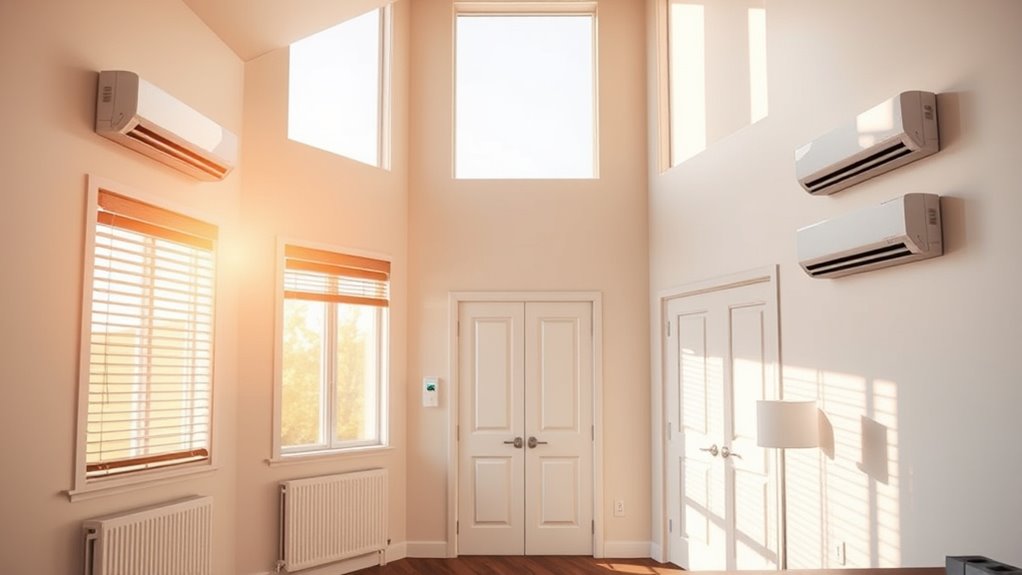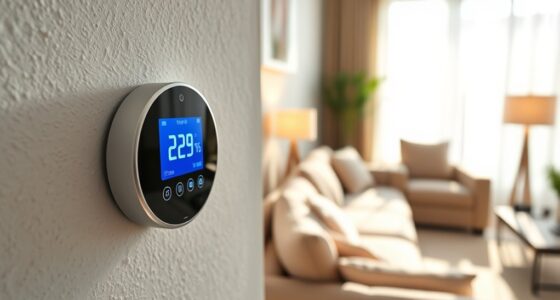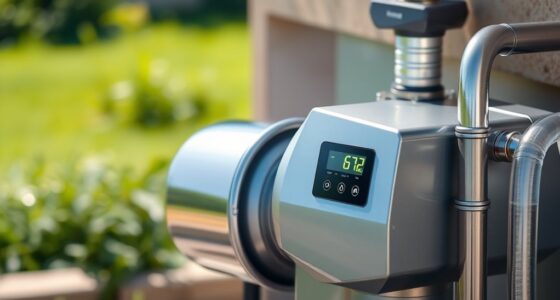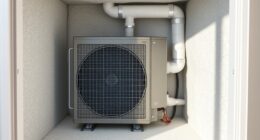By using zoning strategies combined with mini-split systems, you can efficiently target heating and cooling to specific areas of your home or business. This approach helps prevent energy waste by conditioning only occupied zones, which lowers utility bills and reduces environmental impact. Mini-splits offer flexible, ductless installation with advanced inverter technology for customized comfort. Keep exploring how integrating these solutions can maximize your energy savings and comfort, leading to a more sustainable and cost-effective climate control system.
Key Takeaways
- Zoning divides spaces into areas with individual thermostats, reducing energy waste by conditioning only occupied zones.
- Mini splits provide localized heating and cooling, minimizing duct losses and improving overall energy efficiency.
- Combining zoning with mini splits allows precise temperature control tailored to each area’s needs.
- These systems enable selective climate management, lowering utility bills and reducing environmental impact.
- Optimizing energy use through zoning and mini splits enhances comfort while maximizing cost savings.

Reducing energy consumption is essential for cutting costs and protecting the environment. One effective way to achieve this is by implementing zoning strategies in your home or business. Zoning allows you to divide your space into different areas, each with its own thermostat, so you can heat or cool only the parts you’re using. This targeted approach prevents energy waste from conditioning unoccupied spaces, ultimately lowering your utility bills. When you adopt zoning strategies, you gain precise control over your indoor climate, making your heating and cooling systems more efficient. It also enhances comfort because each zone can be set to a preferred temperature without affecting others. This flexibility is especially beneficial in larger spaces or homes with diverse room sizes and layouts.
In this context, mini split systems shine as an ideal solution. Their mini split benefits include easy installation, energy efficiency, and individual zone control. Unlike traditional HVAC units that require ductwork, mini splits are ductless, meaning they deliver conditioned air directly to each zone. This eliminates energy losses associated with duct leaks and reduces overall energy consumption. Plus, mini splits typically have advanced inverter technology, which adjusts compressor speed based on demand. This results in less energy use and consistent comfort. With mini split benefits in mind, you can cool or heat specific zones without affecting the entire building, making them a cost-effective upgrade.
Moreover, mini splits are highly adaptable and can be installed in almost any space, including those where ductwork isn’t feasible. Their compact design allows for discreet placement, and many models come with remote controls, giving you added convenience. When combined with zoning strategies, mini splits enable you to tailor climate control to your exact needs, whether it’s cooling a single room or maintaining different temperatures across multiple zones. This level of control means you’re not wasting energy on areas that don’t require heating or cooling at the moment, which directly translates into lower energy bills and a smaller carbon footprint.
Frequently Asked Questions
How Do Zoning and Mini-Splits Compare in Upfront Costs?
You’ll find that zoning and mini-splits have different upfront costs; zoning typically involves higher installation expenses due to ductwork and system complexity. Mini-splits tend to have lower installation costs because they don’t require extensive ductwork, making them more affordable initially. When comparing costs, consider both the purchase price and installation expenses, as mini-splits often provide a cost-effective solution for targeted heating and cooling.
Can Mini-Splits Effectively Heat and Cool Large Open Spaces?
You might find mini-splits effective for heating and cooling large open spaces, especially with multi-zone systems. About 80% of ductless mini-splits are single-zone, but multi-zone models can handle larger areas efficiently. Ductless mini-splits excel in open spaces because they allow precise temperature control without extensive ductwork. While single-zone units are ideal for small areas, multi-zone ductless systems are better suited for large open spaces, providing flexible comfort.
What Maintenance Is Required for Zoning Systems and Mini-Splits?
You need to regularly replace filters and clean the mini-split units to keep them running efficiently. Check and replace filters every 1-3 months, depending on usage. Additionally, system calibration guarantees your zoning system functions correctly, so schedule inspections and adjustments as needed. Regular maintenance also includes inspecting for leaks, cleaning coils, and ensuring thermostats are working properly, helping you maximize energy savings and extend your system’s lifespan.
Are Zoning and Mini-Splits Suitable for Historic or Retrofitted Buildings?
Zoning and mini-splits can be suitable for historic or retrofitted buildings, but you should consider historic preservation guidelines and retrofitting challenges. These systems offer flexibility and energy efficiency, making them a good choice if you want to minimize invasiveness. However, make certain you work with professionals to address any structural or aesthetic concerns, and verify that the installation complies with preservation standards to protect the building’s integrity.
How Do Zoning and Mini-Splits Impact Indoor Air Quality?
You might think zoning and mini-splits only save energy, but they also improve your indoor air quality. They enable better indoor air filtration, reducing allergens and pollutants, while allowing precise humidity control. This creates a healthier, more comfortable environment. While they provide energy efficiency, they also help you breathe easier, making your space safer and more pleasant. Balancing comfort and health, these systems truly enhance your indoor living experience.
Conclusion
So, next time you’re tempted to crank up the AC everywhere, remember that zoning and mini-splits are your new best friends. Why waste energy cooling empty rooms or paying sky-high bills? With a little effort, you can pretend you’re an energy-saving superhero, saving the planet one cool zone at a time. Who knew that being eco-friendly could be so easy — and way more cost-effective than throwing money out the window? Cheers to smart cooling!









